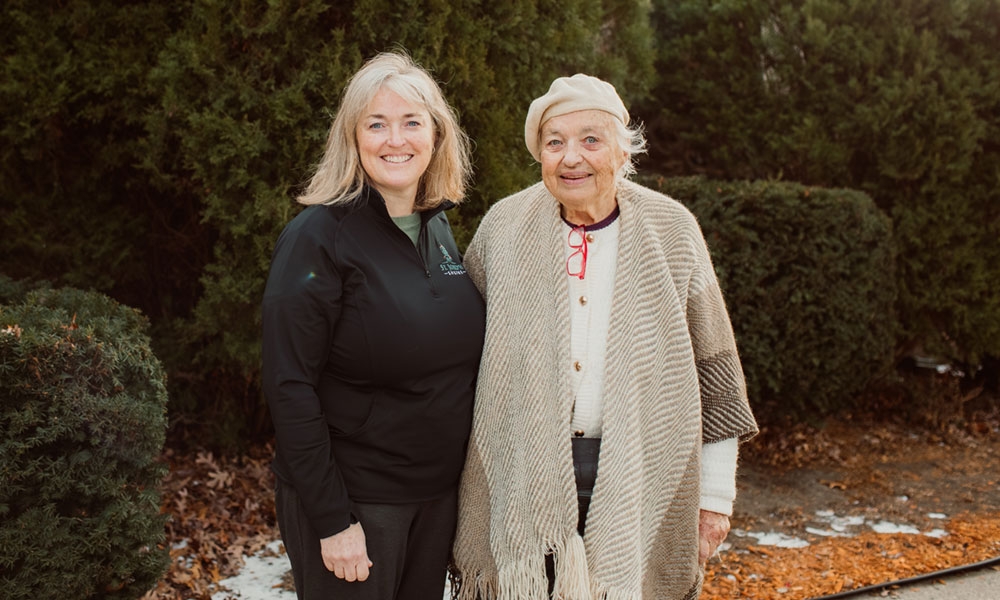
A tiny church with a big history
Getting your Trinity Audio player ready...On Nov. 14th, 1863, Father Edward Van Lauwe said the first Mass at St. Joseph Shrine church near the small town of Brooklyn. Five days later, President Abraham Lincoln gave his Gettysburg Address.
On Nov. 14th, 1863, Father Edward Van Lauwe said the first Mass at St. Joseph Shrine church near the small town of Brooklyn. Five days later, President Abraham Lincoln gave his Gettysburg Address.
“I like to think people in this church prayed for the end of the Civil War,” says Elizabeth Girdham, the church’s executive assistant and a sixth-generation member of the parish.
The little stone church, first served by missionaries beginning in the 1850s, sits quietly on the side of U.S. 12 in Lenawee County, but its history and features make it worth a visit.
“We’d love to invite people to visit the shrine, pray here, and even come with a pilgrimage group, especially to pray the stations,” says Father Zachary Mabee, the shrine’s pastor.
In the 1850s, Irish immigrants settled the area in southern Michigan now known as the Irish Hills, according to the shrine’s historical documents. The land for the church was deeded to Bishop Peter Lefevere in 1851 and priests from surrounding towns served the parish beginning in 1853, even though a church building had yet to be built. They said Mass in private homes.
Irish immigrants began building the church in 1854, and some of that original structure are still part of today’s building, including the fieldstone walls built with stones pulled from local farmers’ fields, Girdham says.
The little church served the faithful for many years, and its members gradually improved and replaced parts of the building, like adding stained-glass windows and a bell tower in 1911, according to church documents.
In 1928, it was enlarged and made into a cruciform shape, and Msgr. Joseph Pfeffer, who served the church at the time, added a red tile roof, mosaic tile decorations, and a small interior shrine modeled after the Lourdes Grotto in France.
Girdham’s mother, D. Lynn Marsh, says the church was without a permanent pastor for its first 100 years.
“For 100 years we had visiting priests, sometimes from as far away as Monroe and other places,” she says.
The church’s first permanent pastor was Father Henry Hengehold, who was appointed in 1954.
Since that time, the “wayside church” has continued to serve many in the Irish Hills area, especially during the summer, when those visiting the area’s lakes need to attend Mass.
Marsh says the church directory used to list the out-of-state home addresses of those who frequented the parish in the summertime, as “regulars” wanted to keep up with them during the rest of the year.
One 1930 summer service, Girdham says, recorded more than 900 attendees. For Masses that large, a tent would be set up in the cemetery to accommodate all those present.
“Cars would be double- and triple-parked on U.S.12.,” she says. “Then in winter, we’d go back to 90 parishioners.”
One more well-known and unique feature of the shrine is its outdoor Stations of the Cross, which were constructed beginning in 1932. Girdham says they were built by seminarians and feature work by Spanish and Mexican artists, as well as stones from around the world.
Somewhere along the way, the church started to be known as a shrine. Girdham suspects it could be because of the stations or the Lourdes grotto or both.
“One of the priests just started corresponding with others and saying it was the ‘St. Joseph Shrine,’” she says. “It was right around the time we became a parish in 1954. We went up to the Lansing archive office and couldn’t find any certificate or ceremony mentioning it.”
Regardless, Mabee says the shrine’s historic church building, grotto, and stations are all draws for those in the diocese looking for a special place to visit and pray.
“The space here is really lovely,” he says.
In 2011, the late Father Dave Hudgins, who served the shrine at the time, led a “heritage project” renovation of the church, preserving its historical elements, like the early 1900s altarpiece and communion rail.
Hudgins, who died in a car accident in January 2022, was beloved by the parish, Mabee says, and is buried in the shrine’s cemetery.
Mabee was appointed to the shrine after Hudgins’ death, and says he has found the church to be exceedingly warm and welcoming.
“One thing that has moved me, and that many people note, is the sense of community here,” he says. “We talk about that a lot with regard to parishes — how a lot of them lack that. Here, it’s very robust, warm, and organic. People really enjoy each other’s company and love each other in a real and deep way. That’s been a beautiful part of being here.”
Girdham says St. Joseph Shrine continues to do what it has done for hundreds of years — collect the faithful from the area, despite it not being located in a town or city proper.
“We’re this little church that can draw people in along the way,” she says.
